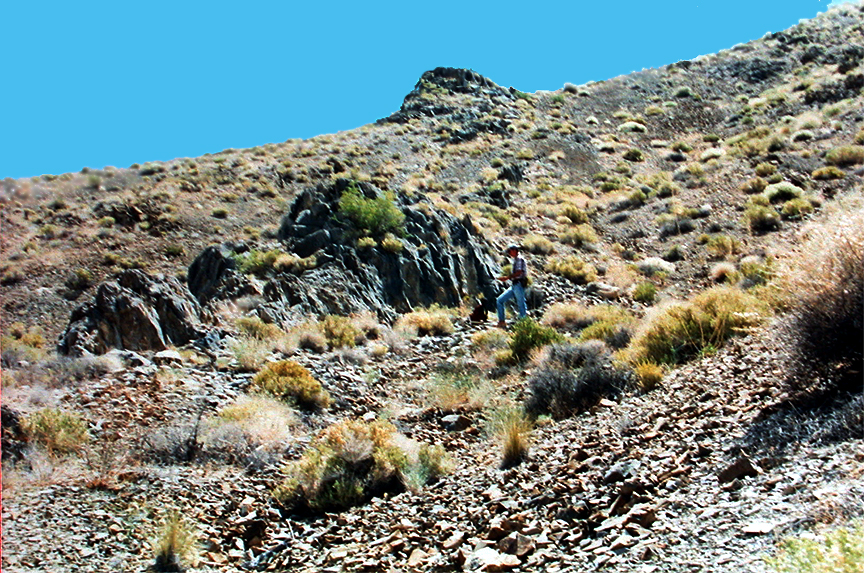


|
Two views of the famous Meekoceras beds ammonoid locality at Union Wash. At top, the view is to the prominent ammonoid-bearing limestone "rib" at the base of the Middle Member of the Lower Triassic Union Wash Formation, where a Mesozoic Era cephalopod enthusiast examines fossiliferuos carbonate rocks. Strata above and to the left of the fossiliferous grayish limestone hump, which stretches from lower left to upper center of photograph, consist of the Permian Lone Pine Formation of the Owens Valley Group, unfossilferous here, but farther south, in the Darwin district, the Owens Valley Group produces abundant fusulinids and huge coral heads. Rocks to the right of the Meekoceras limestone "rib" (a bed that averages roughly three to fifteen feet in thickness) belong to the Middle Member of the Union Wash Formation. At this locality, the lower member of the Union Wash Formation is not present--it was either cut out by faulting, or perhaps was never deposited here to begin with. At bottom, the view is westward across Owens Valley to the Sierra Nevada skyline. A Triassic Period visitor stands atop one of the thicker sections of the Meekoceras carbonate layer. The Meekoceras beds at Union Wash were discovered in 1896 by pioneering paleontologist Charles Doolittle Walcott during one of his epic expeditions to the Western states in search of fossiliferous Early Cambrian exposures. He eventually donated his collection to James Perrin Smith, who determined that the ammonoids were of Early Triassic geologic age, or approximately 248 million years old. Based on the presence of Meekoceras gracilitatus in the fossil collections from Union Wash, Smith assigned the entire fauna to the Meekoceras zone, a zonation/designation that some ammonoid specialists tried to "ban" in favor of the so-called Tardus and Romunderi Zones. Thankfully, that "idea" fell flat on its proverbial face. Smith published his finding on the ammonoid fauna at Union Wash in 1932 in USGS Professional Paper 167, Lower Triassic Ammonoids of North America. He noted that the most distinctive variety recovered from the limestone layers was Meekoceras gracilitatus. Other genera Smith described include Owenities (four species); Ophiceras (four species); Xenodiscus (four species); Anasibirites (three species); Sturia (two species); Lanceolites (two species--this species is now called Dienoroceras); Clispoceras (two species); Lancanites (two species); and six addtional species of Meekoceras. |